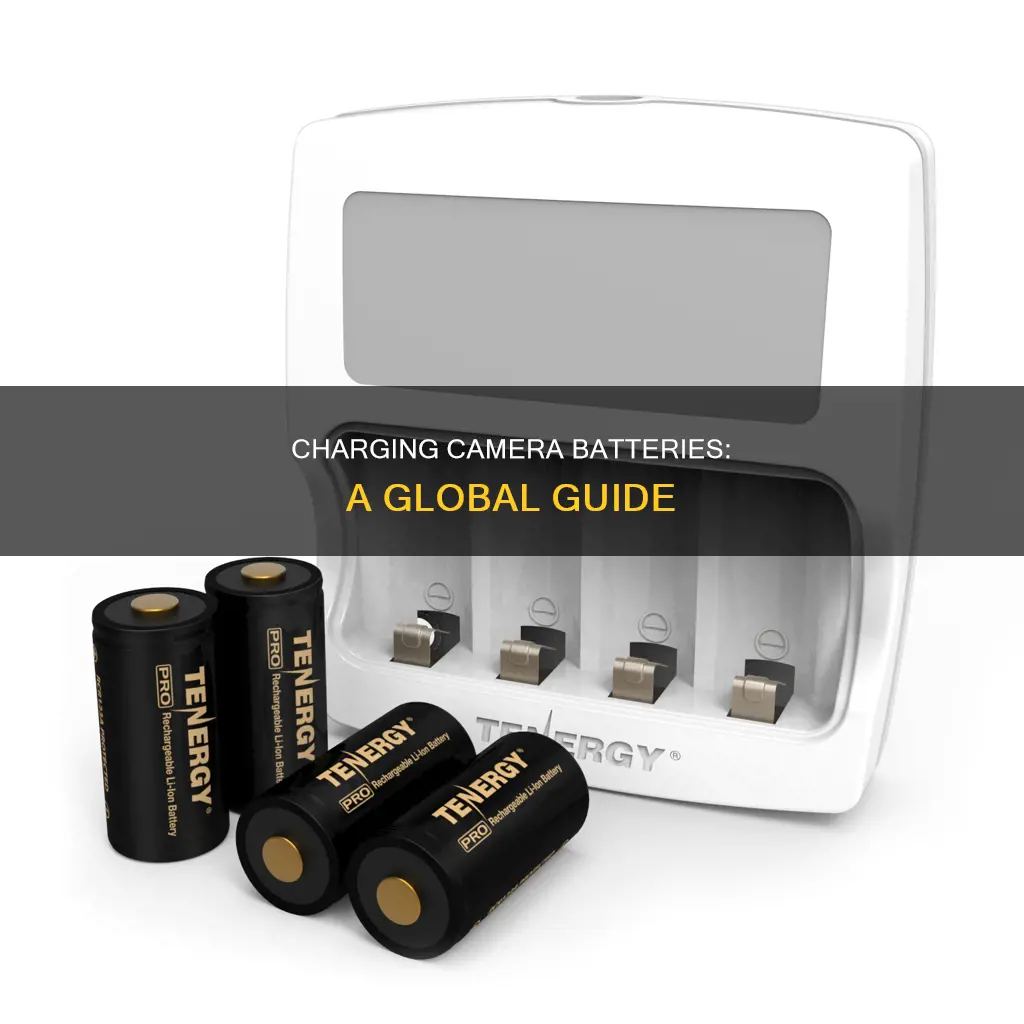
Charging camera batteries in different countries can be a tricky task due to varying electrical systems and voltages. For instance, the US and Canada use 120-volt electrical systems, while European countries operate on 220-240 volts. This is where the importance of voltage compatibility comes into play. Most camera batteries are rechargeable and can be charged using a universal charger designed for a specific battery model, which can automatically adjust to the local electrical supply. However, it's crucial to ensure voltage compatibility to avoid any damage. In some cases, a voltage converter or adapter may be necessary. Additionally, understanding the various plug types used worldwide is essential, as electrical plugs differ in shape and size across regions. Carrying a universal adapter that accommodates multiple plug types can be helpful for travellers. Another convenient option is USB charging, which is becoming increasingly popular and eliminates the need for voltage converters.
| Characteristics | Values |
|---|---|
| Voltage compatibility | Most camera battery chargers are now "universal chargers" or "dual voltage chargers", which can be used in countries with 110-120V (e.g. US, Canada) or 220-240V (e.g. Europe, Australia, New Zealand) electrical systems. |
| Plug types | There are several plug types, including Type A, Type B, Type C, Type D, Type E, Type F, Type G, Type H, Type I, Type J, Type K, Type L, Type M, and Type N. Each plug type corresponds to a specific country or region. |
| Power adapters | Power adapters convert voltage and plug types to match the electrical standards of the country. They are essential when travelling to a country with a different voltage level or plug type. |
| Charging standards | The most common method is USB charging, which is a universal standard. Wireless charging is also gaining popularity. |
What You'll Learn
- Voltage compatibility: Ensuring chargers can adapt to different electrical systems
- Plug types: Understanding the various plug types used worldwide
- Power adapters: Converting voltage and plug types to match a country's electrical standards
- Charging standards: Compatibility with USB and wireless charging
- Travel tips: Managing power and bringing spare batteries

Voltage compatibility: Ensuring chargers can adapt to different electrical systems
When it comes to charging camera batteries in different countries, ensuring voltage compatibility is crucial. Most countries use electricity at around 220-240 volts, while North America, Central America, and parts of Japan typically operate on 110-120 volts. This discrepancy in voltage standards can pose a challenge when travelling with electronic devices such as camera battery chargers.
To address this issue, camera manufacturers often design their battery chargers to be compatible with a broad range of voltages. These "universal chargers" or "dual voltage chargers" can automatically adjust to the local electrical supply, eliminating the need for additional adapters or converters. This feature is essential for travellers, as it ensures their camera batteries can be charged safely and efficiently in various countries without damaging their equipment.
In addition to voltage compatibility, travellers should also be mindful of the different types of electrical plugs used worldwide. The shape and size of plugs vary across regions, so it is advisable to carry a universal adapter that can accommodate multiple plug types. These adapters usually have interchangeable plugs to fit various sockets, ensuring compatibility with the local electrical system.
It is worth noting that USB charging has become increasingly popular for camera batteries. USB charging operates at a standard 5 volts, simplifying the process by eliminating the need for voltage converters or adapters. This method is convenient for travellers as it allows them to charge their camera batteries using a USB cable connected to a computer or a USB wall adapter.
By considering voltage compatibility and understanding the various plug types used worldwide, photographers can ensure they can charge their camera batteries safely and efficiently in different countries. Universal chargers, dual voltage chargers, and the availability of USB charging provide flexibility and convenience when travelling internationally with camera equipment.
Simplisafe Camera Battery: Charging Time Explained
You may want to see also

Plug types: Understanding the various plug types used worldwide
There are 15 types of domestic electrical outlet plugs in use worldwide, each assigned a letter by the US Department of Commerce International Trade Administration (ITA). Here is a guide to understanding the various plug types used around the world:
Type A and Type B
Type A and Type B plugs are mainly used in the USA, Canada, Mexico, and Japan. Type A has two flat prongs, and Type B frequently has a third prong, the "ground". Type B plugs will work in Type A outlets, but not always the other way around. Japanese prongs tend to be smaller, so Japanese devices will work in the US, but not always the other way around.
Type C
Type C, also known as the Europlug, is used across Europe, South America, and Asia. It has two round prongs and is not always grounded. It is compatible with Type E sockets.
Type D
Type D plugs are mainly used in India, Namibia, Nepal, Sri Lanka, and they have three large, round pins in the shape of a triangle. Devices that use Type D plugs will not work with other plug types.
Type E
Type E plugs are found in Eastern Europe and parts of Africa, including Tunisia, Morocco, Slovakia, and Poland. Older buildings in France and Belgium may also have Type E sockets. Type E plugs have two large, round prongs with an "Earth" pin in the middle. They are compatible with Type C plugs.
Type F
Type F plugs are typically found in older buildings in Germany, Austria, the Netherlands, and Scandinavian countries such as Finland, Norway, and Sweden. Devices that work with Type C plugs are also compatible with Type F.
Type G
Type G plugs are used in the United Kingdom, Ireland, Malta, Malaysia, Singapore, and the Arabian Peninsula.
Type I
Type I plugs are mainly used in Australia, New Zealand, China, and Argentina. They have two or three pins, with the three-pin version being grounded.
Samy's Camera: Tax-Free Shopping Experience
You may want to see also

Power adapters: Converting voltage and plug types to match a country's electrical standards
Power adapters are essential when travelling to different countries with varying electrical standards. These adapters allow you to convert voltage levels and plug types to match the electrical supply of the country you're visiting.
Different countries have different electrical systems, which means voltage levels and plug types can vary. For example, the standard voltage in the United States is 120 volts, while in Europe, it is typically 220-240 volts. This difference in voltage can be problematic if you attempt to charge your camera battery without the appropriate power adapter.
Power adapters are designed to convert the voltage from the electrical outlet to the voltage required by your device. They also come with interchangeable plug types that can fit into outlets in different countries. This ensures you can safely and efficiently charge your camera battery, regardless of your location.
It is important to note that not all power adapters are universal. Some may only be compatible with specific voltage levels or plug types. Therefore, it is crucial to check the specifications of your camera battery and the power adapter to ensure they are compatible.
In recent years, advancements in power adapter technology have been made. Some adapters now feature built-in voltage converters, allowing them to automatically adjust to the voltage of the country you are in. This eliminates the need for manual voltage adjustments, making charging camera batteries even more convenient for travellers.
When selecting a power adapter, it is important to consider your specific needs. There are various options available, including USB travel adapters, voltage converters, plug adapters, wireless adapters, dual travel adapter/converters, and universal travel adapters. By choosing the right adapter, you can ensure safe and efficient charging of your camera battery while travelling internationally.
Charging Camera Batteries: Alternative Methods to Try
You may want to see also

Charging standards: Compatibility with USB and wireless charging
USB charging is a convenient way to charge your camera battery when you're travelling, especially if you're far from a power outlet. In recent years, USB charging has become more widespread, with many modern cameras now equipped with a USB-C connection, enabling faster charging and greater power output. This means you can charge your camera battery using a USB cable connected to a laptop, USB plug adapter, or power bank. However, it's important to note that not all cameras support USB charging, so be sure to check your camera's handbook or specifications before attempting to charge via USB. Some older camera models might not support USB charging, and some may require a USB charging converter.
When charging via USB, it's crucial to use a high-quality USB cable, charger, and reliable power supply to ensure secure and effective charging. Additionally, the power output of the USB port is important to consider, as some USB ports may not provide enough power or may take a long time to charge. In such cases, using a specialised battery charger may be more efficient.
Wireless charging is another innovative technology that allows for convenient charging without the need for cables or physical connections. Wireless charging uses electromagnetic induction to transfer power from the charger to the device, and it is effective over distances of up to 4 cm. This technology has been adopted by major manufacturers like Apple and Samsung, and is known as the "Qi" standard. Qi wireless charging is compatible with a wide range of smartphones, including iPhones and Samsung Galaxy models, and can also be used with wireless charging adapters for devices that don't have built-in wireless charging capabilities.
Wireless charging offers several benefits, including convenience, a neater setup with no wires, and the elimination of clutter from tangled cables. However, it is important to note that wireless charging is currently slower than wired charging and may not work through all phone cases. Additionally, wireless charging has been criticised for potentially increasing the rate of battery degradation due to the constant topping up of the battery.
Charging Your Fujifilm Camera: A Step-by-Step Guide
You may want to see also

Travel tips: Managing power and bringing spare batteries
When travelling with camera equipment, it is important to consider how you will keep your devices charged, especially when visiting countries with differing electrical systems and voltage outputs. Here are some tips to help you manage your power supply and ensure you always have a fully charged camera battery.
Check your camera battery charger
Before you travel, check the specifications of your camera battery charger. Most modern chargers are universal, meaning they can handle a wide range of voltage inputs. For example, if your charger is labelled with an AC input range of 100-240V, it will work in countries with electricity outputs of 120V (e.g., the US) and 220-240V (e.g., Europe).
Understand the electrical systems of your destination countries
Different countries have different electrical systems and voltages. For instance, the United States and Canada typically use a 120-volt electrical system, while many countries in Europe use 220-240 volts. This difference in voltage can cause issues when charging camera batteries. Check the electrical output of your destination country to determine whether you will need a power adapter or converter.
Use power adapters
If your charger is not universal, you may need a power adapter to convert the voltage and plug type to match the electrical standards of your destination country. Power adapters are essential to ensure you can safely charge your devices without damaging the battery or adapter. You can purchase universal power adapters that are compatible with multiple plug types, which is ideal if you are visiting multiple countries with differing plug types.
Bring spare batteries
Consider bringing spare batteries with you when travelling. This will ensure that you can continue using your camera while one battery is charging. Generic camera batteries can be purchased at a lower cost than branded batteries, so having a few spares can provide peace of mind and allow you to capture as many photos as you like without worrying about battery life.
Additional tips
- Turn off your LCD display when taking photos to conserve battery life.
- Use a power strip to charge multiple devices at once, which is especially useful when travelling with various gadgets.
- Always check the voltage and frequency requirements of your equipment and the electrical system of your destination country to ensure compatibility.
- Be mindful of any warnings or recommendations from the camera manufacturer regarding charging your battery in different countries.
By following these tips, you can effectively manage your power supply and ensure your camera battery stays charged while travelling to different countries.
Charging Your GoPro: A Step-by-Step Guide
You may want to see also
Frequently asked questions
Most camera batteries are rechargeable and can be charged using a universal charger designed for that specific battery model. These chargers usually have a voltage range of 100-240V and can be used in countries with different electrical systems. However, always check the voltage compatibility of the charger with the local electrical supply before plugging it in. You may need a plug adapter to match the electrical outlet shape of the country you're visiting.
Voltage converters are typically not required for camera battery chargers. Most modern chargers are dual voltage or universal, meaning they can automatically adjust to the voltage of the local electrical supply. However, if your charger is not universal, you will need a voltage converter to match the electrical system of the country you're visiting.
The voltage standards vary across the world. The United States and Canada use a 120-volt electrical system, while countries in Europe, Australia, and New Zealand typically use 220-240 volts. Some countries may use both 110 and 220 volts. Always check the voltage of the country you're visiting to ensure compatibility with your charger.
Plug adapters allow you to connect your charger to different types of electrical outlets in various countries. Different countries have different plug types and outlet shapes. For example, the standard plug in Italy has two thin round prongs. Plug adapters help you physically connect your charger to the wall outlet without changing the voltage.
Yes, many modern cameras support USB charging. This method allows you to charge your camera battery using a standard USB cable connected to a computer, a USB wall adapter, or a power bank. USB charging is convenient when travelling as it eliminates the need for a separate charger or voltage converter.







